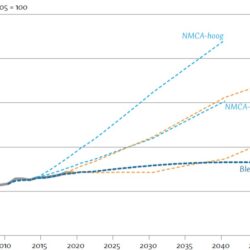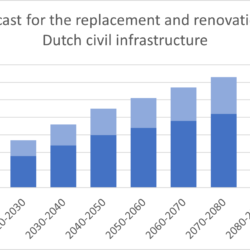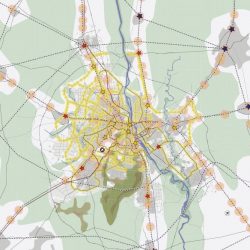Official projections from the Dutch government for the growth in car traffic are too high. The government recognized that car mobility grew slower than expected. Therefore, they almost halved the official growth projection in 2021, only four years after their… Read More
Last year the Dutch court in the Hague ordered Shell to reduce its CO2 emissions by at least 45% by the end of 2030[1]. The ruling includes emissions from the burning of the fuels it sells in cars, trucks, ships and planes. These so-called scope 3 emissions, cover three-quarters of Shell’s total climate impact[2]. Could national road authorities likewise be held responsible for the emissions of greenhouse gases by the users of motorways? The similarities are strong, although there is one major difference.
The environmental report of the Dutch national road authority, Rijkswaterstaat (RWS), shows that 97% of its CO2 emissions are caused by the use of its infrastructure[3]. Operations are only 90 kilotonnes of CO2 (scope 1 and 2), while procurement of materials, transport and construction works add up to 580 ktCO2 (scope 3 upstream). The use of infrastructure is responsible for the bulk of their emissions: 19,000 ktCO2, of which 15,200 ktCO2 by vehicles on their motorways.
A crucial issue in the court case against Shell was whether the oil company is responsible for the greenhouse gases from the use of its fuels. The court judged that the company has a shared responsibility and therefore ordered “a significant best-efforts obligation” to reduce emissions from the use of their fuels.
Also, for National Road Authorities, the question will be whether they have an impact on the CO2 emissions of the vehicles using their motorways? The answer is yes, for new road capacity generates more traffic.
A statistical analysis covering 228 metropolitan areas in the USA shows that 1% extra capacity results in 1% extra traffic[4]. This conclusion is confirmed in an international meta study covering 15 researches[5]. Widening existing highways has a similar effect: a part of the Netherlands with 3% more new capacity than the rest of the country, witnessed an increase of motorway traffic by 4% more than the average[6]. The assessment of the opening of a third highway tunnel near Amsterdam illustrates the changes in mobility behaviour when new road capacity becomes available: 5% more car trips crossing the canal, 16% more cars during peak hours, 11% lower occupancy rate of cars[7].
The impact of new road capacity is illustrated with the planned extension of motorway capacity in the Netherlands. Between 2022 and 2027 4% new capacity will be built. This causes an additional 600 kiloton CO2. This is about the same as the emissions from RWS’ procurement (scope 1, 2 and 3 upstream).
Just like Shell, national road authorities have a shared responsibility for the greenhouse gas emissions of transport. The main difference is that Shell is a private company, while National Road Authorities are public bodies. Being a public body should not be a shield to deflect responsibility. Both need to be transparent about the impact they have on emissions, and both need to take appropriate actions to cut them.
September 2022
[1] The Hague district court 26 May 2021. Shell appealed against this ruling.
[2] Shell Sustainability Report 2021
[3] CO2-Managementplan 2021-2022
[4] The Fundamental Law of Road Congestion: Evidence from US Cities (2011)
[5] Induced Vehicle Travel in the Environmental Review Process (2020)
[6] Do highway widenings reduce congestion? (2022)
[7] Effecten van de openstelling ringweg Amsterdam, Rijkswaterstaat (1992)



